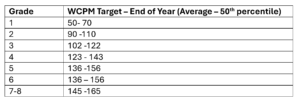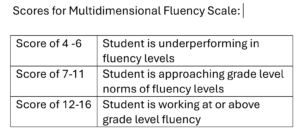Assessing, Screening and Monitoring Fluency
Why should fluency be assessed?
30 years of research, conducted over 3 decades, into the fluency measure of words correct per minute (WCPM), has evidenced that it is a robust indicator of overall reading development throughout the primary grades.
The ability to make meaning from print depends upon the development of word recognition accuracy and reading fluency. Both should be regularly assessed in the classroom. Formative assessments, such as these, inform and allows for, responsive, timely and effective interventions.
Assessing and monitoring fluency allows teachers to understand:
- How a student’s performance compares to their peers?
- If students are at-risk of reading failure?
Assessing and monitoring Oral Reading Fluency (ORF) is an accurate and efficient way to monitor reading progress in the primary grades. ORF is a quick and effective method to identify ‘at risk’ students. It demonstrates a high level of diagnostic accuracy (80%) and only takes 3-5 minutes per student to conduct (Burns et al, 2014).
Listen to Dr Stephanie Stollar discuss the purpose and correct use of fluency screening and monitoring.
How to Effectively Use Oral Reading Fluency in Screening & Progress Monitoring
How is fluency assessed?
Teachers should assess fluency regularly. Monitoring a student’s WCPM throughout the year provides a clear record of their reading progress in terms of accuracy and rate (Konza, 2011). Tracking student progress allows for responsive action through tiered intervention.
**As noted by Dr Konza (2011) basic reading comprehension requires a WCPM rate of between 90-100 words correct per minute, which is achieved around the end of Grade 2**
Measuring Oral Reading Fluency: Words Correct Per Minute (WCPM)
(Time required per assessment: 1minute)
Steps to follow:
- Choose an appropriate ‘at level’ unseen text passage. A text that is on a single page is best *Pictures and page-turning can affect time*
- Have a teacher copy of the text for each child being assessed. Add the word count line by line, already totaled, down the RHS of the text
- Have a timer set for 60 seconds with an alarm (phone works well)
- Student and teacher sit side by side. Read title of text to student. Show them the starting point for the oral reading. Teacher says, “This text is called ………I want you to read this text out loud to me starting from here… (Point to first word) It’s important that you try and read each word correctly. I will ask you a few questions about the text after. You can stop reading when you hear the timer alarm go off.”
- As child reads, teacher marks their own text copy, using marking key and recording observations
- Clearly mark the last word read by the student as the timer goes off
- Ask the child (if you have time and wish to do so) a few quick questions about the text to check basic comprehension. E.g. where did the character go? What was ‘the flash of silver’?
- Count and record the total number of words read correctly
- The WCPM = the total number of words read – number of errors
- Note any important observations about the oral reading: guessing words, code knowledge errors, omitting words, pointing to words, ignoring punctuation, sounding out, etc. These become teaching focuses in future lessons
(Sourced from Reading Science in Schools Website – Fluency)
Note: No one WCPM rate, is used for all students. Student WCPM rates will increase as they grow older. Reading rate must be measured against a table of grade level norms.
These norms for oral reading fluency (ORF) can be used to help educators make decisions about which students are at risk and might need intervention. It can also be used to help monitor student progress once instruction has begun.
Hasbrouck and Tindal (2017) published comprehensive fluency norms for Grade 1-Grade 6. These were based on a sample size of 6,886,582 ORF scores collected from DIBELS 6th Edition, DIBELS Next and easy Curriculum Based Measurement (CBM) assessments
The norms can be viewed here: https://files.eric.ed.gov/fulltext/ED594994.pdf
As a rough guide, the target WCPM at the end of year level are:

(Sourced from Reading Science in Schools Website – Fluency)
Reading Fluency – Prosody Rubrics
Prosody can be measured through a qualitative rubric, whereby teachers listen to children reading an age-appropriate text and rate their reading according to the rubric descriptors.
This rubric, by Dr Rasinski, monitors prosody in addition to WCPM. Please find attached a link to this rubric for your reference EARS Multidimensional Fluency Scale.pdf (Rasinski & Cheesman Smith, 2025, Mega Book of Fluency) Proficiency requires students to marked within the top half of the rubric.
Scores for Multidimensional Fluency Scale:

Fluency Accuracy and Automaticity: Rasinski’s Assessment and Norms
WRC/ WCPM Accuracy:
Equation: WRC (WCPM) / TWR
Total number of words read correctly divided by Total words read (correct or corrected + uncorrected errors). Example: 137 words read correct / 145 total words read (137 correct + 8 uncorrected errors) = 94.5% correct.
Interpretation: 99% Correct: Independent Level Reading
95% Correct: Instructional Level Reading
90% Correct: Frustration Level Reading
Procedure: Ask the student to read orally for one minute from grade-level text. Ask the student to read in his normal manner, not overly fast or slow. Administer at least three times per year.
Scoring of WRC (WCPM): Count the number of words read correctly in one minute (Include errors corrected)
Analysis and Interpretation: Students that are reading significantly below the stated norms (20% or more) are at risk in reading decoding and/or fluency. Further assessment and diagnosis should be considered.
Adapted from: Hasbrouck, J. E. & Tindal, G. (1992). Curriculum-based oral reading fluency forms for students in Grades 2 through 5. Teaching Exceptional Children, (Spring), 41-44. and Howe, K. B. & Shinn, M. M. (2001). Standard reading assessment passages (RAPS) for use in general outcome measurements: A manual describing development and technical features. Eden Prairie, MN: Edformations.
How to monitor and track fluency development?
A tracking spreadsheet is a great suggestion to can be used to monitor fluency progress for Prep/ Foundation to Year 6.
The following fluency tracker was created and shared by Jasmyn Hall via Reading Sciences in Schools (RSIS Australia). Love when educators share their resources!
The RSIS team were a team of educators whose goal was to open up the world of SOR (Science of Reading) and effective pedagogical practices to Australian teachers. They were responsible for the Syntax Project which has since been taken over by Ochre Education a non for-profit organisation who have since renamed it the Grammar Project. Resources from RSIS have been archieved, however they are still available via the link provide. ttps://readingscienceinschools.squarespace.com/
Projects | Australian Education Research Organisation
Ochre resources | Australian Education Research Organisation
Jasmyn used, normative data by Hasbrouck & Tindal (Grade 1 onwards), to automatically calculate WCPM and the percentile rank for the student at that point in the year. This colour coding allows for quick and easy identification of children below the average range for their age.
https://drive.google.com/file/d/16nmlmFM0cSYB-s2cBNJzKr_LtI6_yMAN/view?usp=sharing
Fluency Tracker 2021.xlsx – Google Drive
